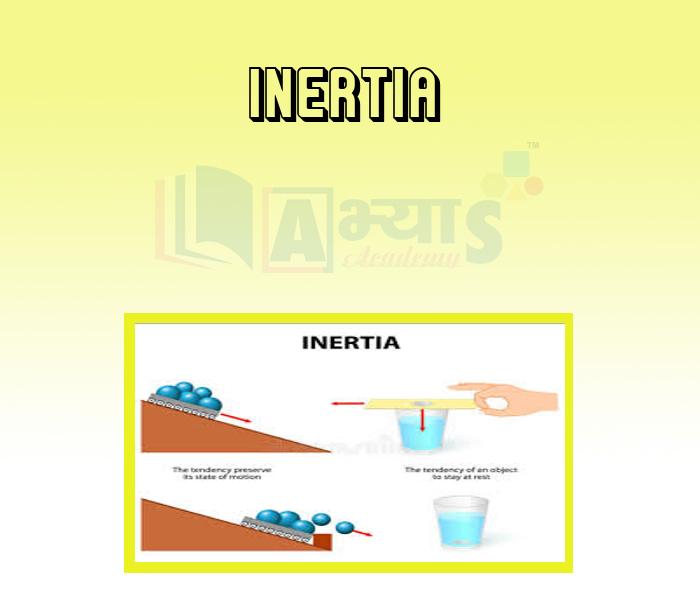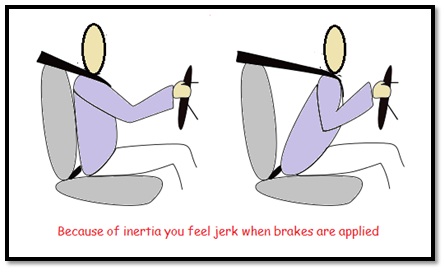Inertia






Inertia
A body can not change its state of rest or uniform motion unless an unbalanced force is applied on it. The inability of a body to change on its own its state of rest or uniform motion is known as inertia. It is an inherent property of all objects. Inertia of an object is measured by its mass. Inertia is directly proportional to the mass. It means that inertia increases with increase in mass and decreases with decreases in mass. A heavy object will have more inertia than a lighter object. For example:
1. Inertia at Rest:
If we keep a body at rest, it remains there for any length of time if no force is applied on it, is called inertia of rest. It may also be defined as the tendency of the body to oppose any change in state of rest.
Examples:
(i) Jerks while travelling: When we stand in a bus and the bus starts suddenly, we tend to fall backward. This is because our feet are in contact with the floor of the bus and the friction at the contact is high. This force does not allow the feet slip on the floor. The feet move forward with the floor. The upper body does not feel the forward force immediately and remains at rest for a while. So, the upper part of our body gets jerked backward.
Similarly, when the bus stops suddenly, the feet come to rest immediately, but the upper body continues to move in forward direction. So, we tend to fall forward.
(ii) Card Coin Experiment: Place a coin a smooth card kept on a glass as shown. Flick the card sharply in the horizontal direction. The card flies away and coin drops into the glass.

Explanation: By applying force the card is accelerated and moves away. Since the friction between card and coin is negligible, there is no force on the coin in the horizontal direction. It remains in its original position due to inertia of rest.
(iii) Carpet beaten to remove dust particles : The carpet is beaten with a stick to remove the dust particles.
Explanation: When the carpet is beaten there is motion in the carpet but the dust particle do not change the state of rest as no force is applied on them hence do not move with the carpet. these dust particles get separated from the carpet because of inertia of rest.
(iv) Striking a Pile of Carrom Coins: In a pile of coins, by hitting the bottom coin hard with a striker. The lowest coin will move away, but the rest of the pile will remain at the original position.
Explanation: The striker applies force on the lowest coin and it moves but the rest of the pile remains at its place due to inertia of rest. As the lowest coin moves very fast, any force exerted by it on the coins above it is for a very short time, which is not able to move the upper coins in the horizontal direction.


Similarly, when the bus stops suddenly, the feet come to rest immediately, but the upper body continues to move in forward direction. So, we tend to fall forward.
2. Inertia of Motion:.
The tendency of the body to continue its state of uniform motion even until some unbalanced force is applied on it is called as inertia of motion. It may also be defined as the tendency of a body to oppose any change in its state of uniform motion. For example:
Examples:
(i) Forward jerk when moving vehicle stops suddenly:. When a running vehicle stops suddenly,the passenger is jerked forward.
Explanation: In a running car, the whole body of passenger is in the state of motion. As the car stop suddenly, the lower part of his body being in contact with the car, comes to rest but its upper part remains in the state of motion due to inertia of motion. Thus he gets jerked forward.

(ii). In an event of long jump, an athlete runs fast before making a jump.
Explanation: Due to inertia of motion even when the athlete stops running and jumps his body is in motion and hence he is able to jump to a longer distance.
3. Inertia of Direction:
The tendency of the body to continue in the same direction until some unbalanced force is applied on it is called as inertia of direction. It may also be defined as the tendency of a body to oppose any change in its direction of motion is known as inertia of direction.
For Example:
(i) When a fast moving bus negotiate a curve on the road, then passengers fall away from the centre of the curved road.
Explanation: In a moving bus the passengers are in motion along with the bus. As the bus negotiates a curve the part of the body which is in contact with the bus will move along with the bus, but the upper part of the body will not change its direction due to inertia of direction and hence will fall away from the center of the curved road
(ii) The sparks produced during sharpening of a knife against a grinding wheel leaves tangentially to its rim.
Explanation: When grinding is being done the tiny pieces on the surface of the grinding wheel get broken and fall in the form of sparks from the wheel. Before breaking they were in motion along with the wheel, but after breaking they will not change their direction due to inertia of direction These small stone pieces had a linear velocity in the tangential direction before breaking off from the stone.Hence they leave the grinding wheel tangentially to the rim of the wheel.
(iii) A stone tied to string is whirling in a horizontal circle. If the string breaks, then the stone flies away tangentially.
Explanation: The force required for changing the direction while whirling a stone in a horizontal circle is provided by the tension in the string. If the string breaks, the force that was acting on the stone to change the direction has become zero. The stone will not change its direction of motion because of inertia of direction and Hence, it flies away tangentially.

The following is the measure of inertia of an object ? | |||
| Right Option : B | |||
| View Explanation | |||
When we stand in a bus and the bus starts suddenly, we tend to fall ___________ | |||
| Right Option : B | |||
| View Explanation | |||
Which of the following has the largest intertia? | |||
| Right Option : D | |||
| View Explanation | |||
Students / Parents Reviews [10]
About Abhyas metholodology the teachers are very nice and hardworking toward students.The Centre Head Mrs Anu Sethi is also a brilliant teacher.Abhyas has taught me how to overcome problems and has always taken my doubts and suppoeted me.

Shreya Shrivastava
8thA marvelous experience with Abhyas. I am glad to share that my ward has achieved more than enough at the Ambala ABHYAS centre. Years have passed on and more and more he has gained. May the centre flourish and develop day by day by the grace of God.

Archit Segal
7thMy experience with Abhyas is very good. I have learnt many things here like vedic maths and reasoning also. Teachers here first take our doubts and then there are assignments to verify our weak points.

Shivam Rana
7thMy experience was very good with Abhyas academy. I am studying here from 6th class and I am satisfied by its results in my life. I improved a lot here ahead of school syllabus.

Ayan Ghosh
8thOne of the best institutes to develope a child interest in studies.Provides SST and English knowledge also unlike other institutes. Teachers are co operative and friendly online tests andPPT develope practical knowledge also.

Aman Kumar Shrivastava
10thAbhyas Methodology is very good. It is based on according to student and each child manages accordingly to its properly. Methodology has improved the abilities of students to shine them in future.

Manish Kumar
10thI have spent a wonderful time in Abhyas academy. It has made my reasoning more apt, English more stronger and Maths an interesting subject for me. It has given me a habbit of self studying

Yatharthi Sharma
10thBeing a parent, I saw my daughter improvement in her studies by seeing a good result in all day to day compititive exam TMO, NSO, IEO etc and as well as studies. I have got a fruitful result from my daughter.

Prisha Gupta
8thAbhyas is a complete education Institute. Here extreme care is taken by teacher with the help of regular exam. Extra classes also conducted by the institute, if the student is weak.

Om Umang
10thIt has a great methodology. Students here can get analysis to their test quickly.We can learn easily through PPTs and the testing methods are good. We know that where we have to practice
